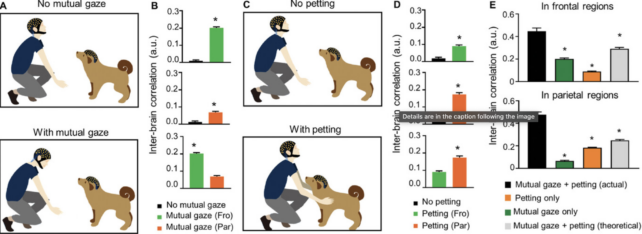When you’ve ever gazed into the huge, watery eyes of a canine and out of the blue felt linked, you might need been experiencing a second of mind synchronization.
For the primary time, researchers in China have discovered neural exercise syncing up between two totally different species: people and canine. The findings counsel we actually do bond with our pets on a deeper neurological degree.
Beforehand, research have proven that when people are speaking or working with each other, our mind exercise in key areas can sync up. However that is the primary collection of experiments to report an identical phenomenon between people and one other species.
The researchers measured mind exercise in people and canine by inserting electrodes on the cranium. For the trial, 10 younger beagles had been matched with unknown people, and the pairs received to know one another over the course of 5 days.
Within the experiments, the human-dog pairs engaged in nonverbal communication, akin to mutual gazing or a superb outdated pat. As a management, the human and canine additionally stayed in the identical room and didn’t work together.
“We noticed that inter-brain correlations in frontal and parietal areas dramatically elevated… throughout mutual gaze,” the authors of the examine write, led by biologist Wei Ren from the Chinese language Academy of Sciences.
When the human contributors had been simply petting the canine, the staff noticed comparable patterns of synchronization, however on this case the synchrony was stronger within the parietal mind area.
In people, exercise in each the frontal and parietal mind areas is related to joint consideration. Earlier research have discovered that when people pet their canine, their frontal lobe exercise spikes, which suggests they’re paying shut consideration to their pet and are emotionally engaged. However it’s not been clear till now whether or not this exercise was mirrored within the canine’s mind.
Within the present examine, when people had been requested to pet the canine and gaze into their eyes, the inter-brain exercise between the 2 was much more linked than once they had been merely patting or merely gazing on the canine.

To determine which mind was main this rhythmic neural dance, the human’s or the canine’s, researchers employed a particular mathematical algorithm.
Plugging within the information from every human-dog interplay, the staff discovered it was the human brains that had been initiating the coupled neural exercise. Over the course of the examine, inter-brain synchronization between the human-dog pairs grew, which suggests the 2 had been bonding.

Some scientists hypothesize that deficits in social cognition, seen in autism spectrum dysfunction ( ASD), consequence from decreased mind synchronization with others.
To analyze this speculation additional, researchers carried out the identical experiments over once more, however this time with 9 canine who confirmed comparable traits to human ASD. On this case, the human-dog pairs confirmed much less inter-brain synchronization, indicating decreased joint consideration.
LSD has been proven to boost the social conduct of mice in earlier research, so researchers tried giving the canine with traits of ASD a single dose of this psychedelic. The drug in the end improved the canine’s synchronization with their paired people.
Whereas the examine is simply small and additional analysis is required, these canine might be a helpful mannequin for finding out the neural mechanisms underlying the social deficits related to ASD, the researchers say.
“Our findings counsel potential inter-brain exercise biomarkers for ASD analysis and improvement of engineered non-hallucinogenic analogs of LSD to right social deficits,” the authors conclude.
The examine was revealed in Superior Science.



